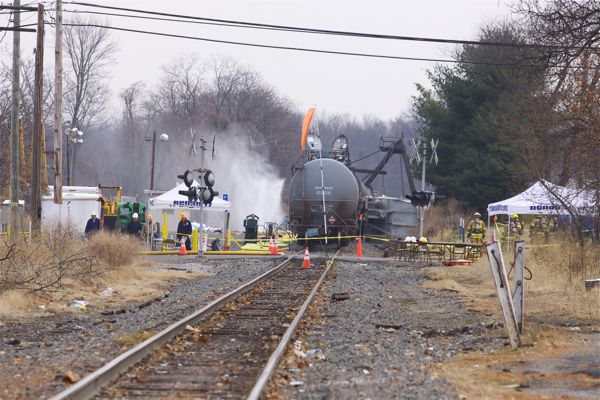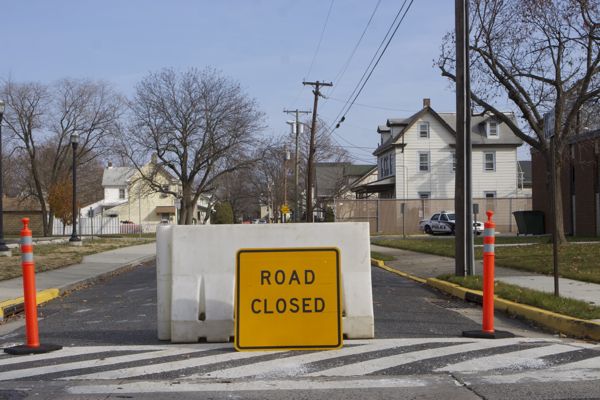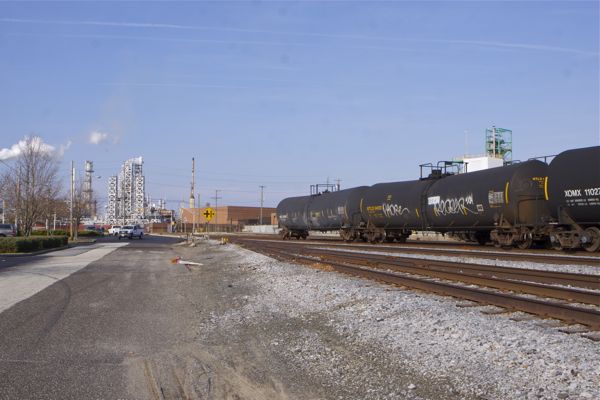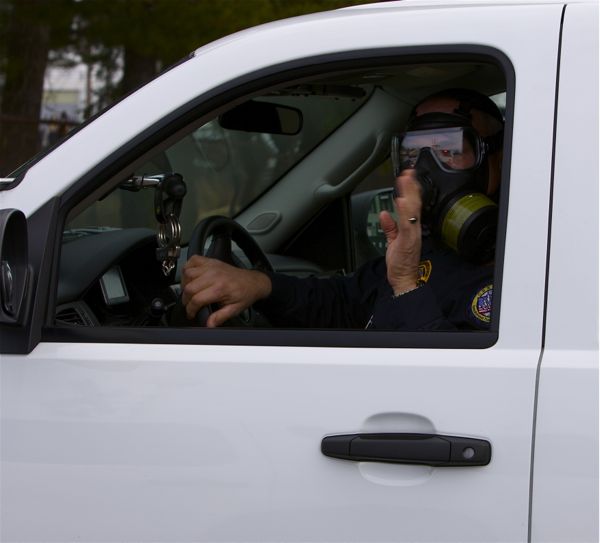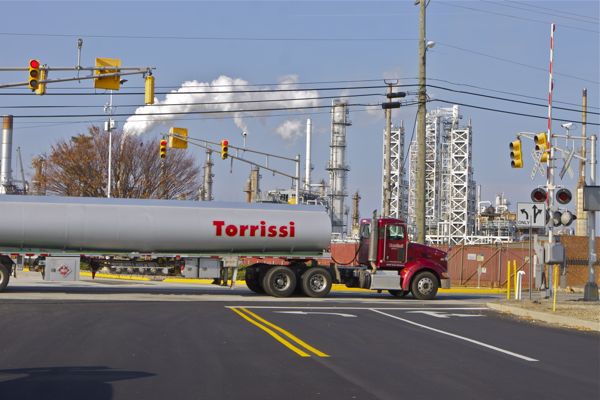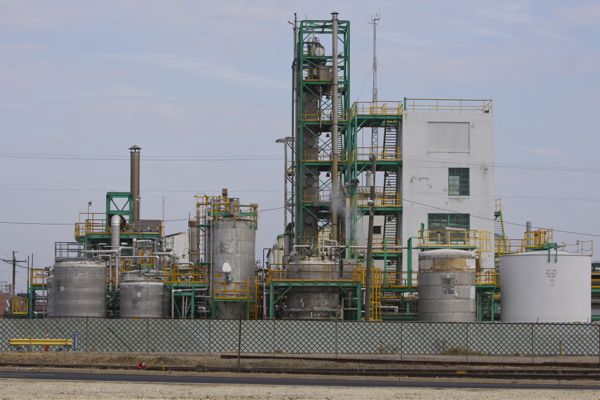Toxic Train Wreck – “Shelter in Place” is Modern Version of “Duck & Cover”
Paulsboro a Sacrifice Zone for Chemical Industry
“Too Dangerous for a Public Meeting, But Not Dangerous Enough to Evacuate”
[Update: watch this NJTV segment, which was the lead story on the show tonight – I got air time interview and ridiculed the concept of “shelter in place” and called out Gov. Christie and Assemblyman Burzichelli for seeking to roll back State standards to minimum federal requirements (watch):
Shelter in Place Order Still in Effect After Paulsboro Train Derailment
Bill Wolfe is a former planner and policy analyst for the state Department of Environmental Protection. He edits a website now that calls attention to environmental issues. He says shelter in place does little but give a false sense of security.
“Shelter in place is what I grew up in as ‘duck and cover.’ The idea that you could somehow shelter in place and be safe from these risks is ludicrous on its face,” Wolfe said. …
These facilities are part of a chemical industrial complex that stretches for about 20 miles along the banks of the Delaware River. Paulsboro is a community that’s pretty much in the middle of that. We were at Paulsboro High School, about a football field away from those facilities.
“The industry has created maps showing where there is called a ‘kill zone’ where in the event of an accident like this, had that been a chlorine tank, literally hundreds or thousands of people could have been killed, instantly,” Wolfe said.
Burzichelli says a combination of organizations regulate chemical plants in towns like Paulsboro and surrounding communities. “Air standards are federal and state DEP and the Department of Environmental Protection, of course, has a bigger role, at the plants that are based here,” he said.
But Wolfe says the Christie administration, along with Burzichelli, have been moving toward allowing local chemical plants to follow the less stringent federal standards.
“He has introduced legislation to weaken two things, both the federal — to make state standards weaker to be consistent with their weaker minimum federal requirements. He’s got a bill in on that. He’s got another bill in that would limit and weaken the DEP’s ability to enforce the laws,” Wolfe said.
I also mentioned Senate President Sweeney’s remarks attacking DEP regulation, but they got edited out.
BTW, I just realized in a prior post, I used an apt term metaphorically, but who knew I had a crystal ball?:
I forsee a series of train wrecks, as DEP implements Governor Christie’s pro-business “regulatory relief“ policies that are codified in Executive Orders #1-4. The framework and foundation for implementation of those policies was laid during 2010. (3/22/11)
And the icing on the cake was the attempt by Paulsboro refinery security goons to run the NJTV crew off – demanding that no photos be taken of the refinery and exposed tanker cars. Last time I was in Paulsboro, I wound up in jail for that. – end update]
I went down to Paulsboro this morning to witness last Friday morning’s toxic train disaster, see:
- Toxic Chemicals Released In South Jersey Train Accident Force Evacuation
- Toxic Train Wreck – The Product is the Problem
It was an erie scene –
The neighborhood near the site was evacuated (as of 6 pm, I learn that the evacuation zone has just been expanded and the “shelter in place” guidance rescinded). Schools are closed for the week. Roads were closed in a 1/4 mile perimeter. Police and emergency response personnel were everywhere. Helicopters hovered. The train cars remained in a jumble as emergency response officials still had not removed the train cars with the chemicals.
Paulsboro is toxic ground zero and a sacrifice zone for the chemical industrial complex. There are several major chemical and refinery facilities in town and the region, including 30 chemical plants along the Delaware River that handle “extraordinarily hazardous substances” that if leaked could immediately kill thousands of people or whose long term exposure causes cancer.
Paulsboro is a text book illustration of the consequences of the political power of the chemical industry, which has delayed, weakened, and frustrated effective regulation of chemical safety.
I arrived early for an on camera interview with NJTV (the old NJN), so I rambled around and took a few photos – the wreck remained in place:
But let me make a few policy points in addition to the photos.
When I was a kid, the civil defense authorities were promoting “duck and cover” – a political propaganda program said to be a defense to a Soviet nuclear attack.
Scientists at the time knew that this was pure nonsense, but they said nothing in deference to the power of the Cold War Civil Defense mania and nuclear Priesthood.
Today, we see the same thing – as government officials talk about using duct tape to “shelter in place”. Absurd on its face.
As I wrote previously, the rail safety aspects are not the main story – but instead illustrate serious problems with how we regulate chemicals and chemical plant safety.
First, this shows piecemeal and disjointed laws and regulations, riddled with huge loopholes.The same chemical is regulated very differently on railroads, trucks, and at facilities at the state and federal levels.
Second, it illustrates a severe weakening in the regulatory fabric, as decades of industry attacks on government regulation have effective transformed now taboo “command and control” regulation into largely voluntary measures and private industry self regulation schemes.
Third, is shows why NJ needs stricter state standards than federal munimums and why Governor Christie’s Executive Order #2 seeking “regulatory relief” and rollback of NJ’s strict state standards to minimum federal standards is bad public policy.
Fourth, it shows the depletion of DEP capabilities, resources, and expertise.
Let me trace some recent history and the trajectory of the primary envrionmental programs to support these points.
I) Promise of Pollution Prevention Act Betrayed
In 1990 – the NJ Legislature passed the groundbreaking Pollution Prevention Act.
The Act required chemical plants to prepare a Pollution Prevention plan. The Act was supposed to usher in a new era of “toxics use reduction” and force the chemical industry to consider safer alternatives and less hazardous substitute products, processes, and chemicals.
While the law mandated that industry prepare the pollution prevention plans, it gave DEP the hammer to mandate implementation of the plans in the various DEP air and water pollution and waste management regulatory program permits.
The industry viewed the act as an existential threat, and lobbied vigorously behind the scenes to kill it in its crib.
Industry won: DEP never adopted regulations to implement this authority to require that pollution prevention plan reductions be enforced via DEP permits. Thus, the promise of the Act was never realized, as industry went back to business as usual.
Ironically, in response to valid industry criticism of piecemeal “silo” or individual pollution “source by source” regulation, the Act also created a pilot program, called “Facility-wide Permitting” (FWP), designed to look at the totality of a plant’s production processes and pollution.
Fourteen (14) FWP pilot studies were conducted. They found huge opportunities to reduce pollution by as much as 50%, while streamlining regulatory paperwork and reducing industry compliance costs.
But these studies were too complex for the environmentalists and impacted communities to understand, DEP made no effort to solicit public support for them, and they thus got no support. The industry opposed implementation of the pilot program statewide, because they did not want to spend the money to upgrade their operations and modernize plants.
Facing strong industry opposition and with no public support, the FWP program was abandoned.
The bottom line?
- Toxic use reduction policy – killed outright
- Pollution Prevention planning – never enforced by DEP and made voluntary
- FWP – findings ignored, program killed outright
II) Chemical Plant Safety – Voluntary Measures
We see a similar pattern in chemical plants safety, as promising laws were gutted behind the scenes at DEP and then transformed into voluntary industry self regulation.
In the wake of the 1984 Bhopal India chemical catastrophe, where thousands of people died, the NJ legislature passed the NJ Toxic Catastrophe Prevention Act (TCPA).
The Act required industries that used “extraordinarily hazardous” chemicals to prepare risk management plans. The thrust of the NJ law was later adopted at the federal level in the 1990 Clean Air Act amendments as the “Accident Release Prevention Program” (ARP).
A similar story ensued – under the Act, the risk management plans were mandatory, but implementation of the plans was left up to industry or DEP enforcement.
Again, DEP did little and – absent a DEP mandate – industry made marginal voluntary changes. The most effective changes were at public water facilities, who reduced their use of deadly chlorine gas (at public expense).
A decade after passage of TCPA, in 1995, in response to industry pressure, under the guise of a “federal consistency policy” (virtually identical to Gov. Christie’s Executive Order #2) the Whitman Administration attempted to weaken NJ’s TCPA standards and roll then back to the weaker minimum federal ARP requirements. But that move was blocked, after I leaked this DEP memo:
“Industry (e.g., CIC and NJBIA) would obviously prefer backing off to the EPA thresholds. However, the increases made by EPA on adoption were so large (averaging some 18 times the TCPA values with 33 of the 60 substances common to both lists assigned from 5 to 167 times corresponding TCPA values) that they are not technically justifiable in an area as densely populated as New Jersey where substances are generally handled on small sites, and would correlate with a significant increase in the number of potential fatalities.”
I think we see exactly what that “densely populated” risk basis means in Pauslboro right now.
Meanwhile, the industry developed its own voluntary chemical safety program called the Orwellian “Responsible Care“. (is it responsible to manufacture a chemical that if leaked could kill 100,000 people nearby?) This voluntary code was advocated as an alternative to government regulation.
A decade later, the Corzine Administration attempted reforms, via a new “Inherently Safer Technology” (IST) program.
But again, The Governor, the Legislature, and DEP buckled to industry pressure and the IST program also is purely voluntary.
The bottom line:
- Stricter NJ State standards remain under attack
- mandatory plans + voluntary implementation = business as usual
- Private schemes urged to replace government regulation
- DEP resources and capabilities cut – that explians Coast Guard lead
(and I did not mention the fact that DEP air pollution control regulations do not require that industry monitor air quality at the fence-line of their facilities and that risk assessment and air quality modeling are voluntary).
After 30 years of attacks on government regulations as “job killing red tape”, we finally see the consequences and logical outcome in Paulsboro:
A powerful industry that can resist effective regulation and a weak DEP that is ill prepared to prevent or respond to chemical disasters.
